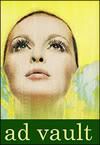
This cover of Harpers Bazaar is a photograph of model Jean Shrimpton by photographer Richard Avedon. Art directors Ruth Ansel and Beatriz Feitler was responsible for this iconic Harper's Bazaar April 1965 cover. Jean Shrimpton is peering from behind a bright pink Day-Glo space helmet with the logo vibrating against it in acid green. It won the New York Art Director's Club medal and has been often reproduced as an emblem of the sixties.
The issue were produced with and without the lenticular blinking eye.
On October 17, 2005, the 40 greatest magazine covers of the last 40 years were unveiled at the 2005 American Magazine Conference (AMC) in Puerto Rico, by Mark Whitaker, Editor of Newsweek and President of American Society of Magazine Editors (ASME), and AMC Chairman Evan Smith, Editor of Texas Monthly. This issue placed #15 on the list.
"The outstanding experience for me working with Avedon was when he guest edited Bazaar’s April 1965 issue. It was an issue devoted to youth culture—Pop, Rock, and the Sexual Revolution. This issue was our attempt to create a magazine on the highest level. It was our way of conceptualizing a magazine from cover to cover with Dick [Avedon] acting as both the editor and
sole photographer. It flowed like a piece of music. It was
to tell everything that was current and future in art, fashion, science, and music.
to tell everything that was current and future in art, fashion, science, and music.
We got permission from NASA to put model Jean Shrimpton in a space suit and photograph her on our cover and inside our issue as the first woman astronaut. It caused a sensation. That was well before its time, nobody believed a woman would become an astronaut, and of course we know differently now. We felt the magazine should reflect the sense of the contemporary scene at the time, so we asked rising talents like the sculptor George Segal, the painters Andy Warhol, Roy Lichtenstein, and Robert Rauschenberg to work with us. The issue was filled with the newest and most advanced young writers—Renata Adler, Bruce Jay Friedman, and so on. But the issue scared a lot of people at the top at Bazaar. They had started to become concerned with the economics of the market and turned their back on anything original or artistic. This signaled that the ship was beginning to sink. Shortly thereafter, Dick left for Vogue to follow Vreeland, and a creative door had clearly been shut forever."







No comments:
Post a Comment